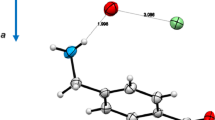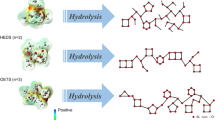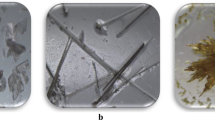Abstract
1H NMR, DSC and TG were used for investigating nine aliphatic sulfones. The most suitable solvent – diethyl ether – was used for its purification by recrystallisation. The thermal stability of these substances was studied; it is comparable to ethylene carbonate and can be increased by using a RSO2R' with (a) longer carbon chain in any R and R' and (b) linear R and/or R' instead of branched one(s). Melting parameters of 8 sulfones were obtained for the first time and the enthalpy and temperature of (n-C4H9)2SO2 were revised. Four of 9 sulfones have melting point below the room temperature. A C4 radical possibly is optimal to get a lower m.p. Melting point decreases in a row both linear R > both branched R ≥ one branched R. Additionally, the attempts to reevaluate SO2 increment value were made.




Similar content being viewed by others
References
Acree W Jr, Chickos JS. Phase transition enthalpy measurements of organic and organometallic compounds. Sublimation, vaporization and fusion enthalpies from 1880 to, 2015 Part 1 C1–C10. J Phys Chem Ref Data. 2013;45:033101.
Acree W Jr, Chickos JS. Phase transition enthalpy measurements of organic and organometallic compounds and ionic liquids. Sublimation, vaporization, and fusion enthalpies from, 1880 to 2015 Part 2 C11–C192. J Phys Chem Ref Data. 2017;46:013104.
Domalski ES, Hearing ED. Heat capacities and entropies of organic compounds in the condensed phase Volume III. J Phys Chem Ref Data. 1996;25:1–525.
Sun X, Angell CA. Doped sulfone electrolytes for high voltage Li-ion cell applications. Electrochem Commum. 2009;11:1418–21.
Scheers J, Fantini S, Johansson P. A review of electrolytes for lithium–sulphur batteries. J Power Sour. 2014;255:204–18.
Shao N, Sun XG, Dai S, Jiang DE. Electrochemical windows of sulfone-based electrolytes for high-voltage Li-ion batteries. J Phys Chem B. 2011;115:12120–5.
Tan S, Ji YJ, Zhang ZR, Yang Y. Recent progress in research on high-voltage electrolytes for lithium-ion batteries. ChemPhysChem. 2014;15:1956–69.
Abouimrane A, Belharouak I, Amine K. Sulfone-based electrolytes for high-voltage Li-ion batteries. Electrochem Commun. 2009;11:1073–6.
Lee SY, Ueno K, Angell CA. Lithium salt solutions in mixed sulfone and sulfone-carbonate solvents: a Walden plot analysis of the maximally conductive compositions. J Phys Chem C. 2012;116:23915–20.
Clever HL, Westrum EF Jr. Dimethyl sulfoxide and dimethyl sulfone. Heat capacities, enthalpies of fusion, and thermodynamic properties. J Phys Chem. 1970;74:1309–17.
Xu K, Angell CA. High anodic stability of a new electrolyte solvent: unsymmetric noncyclic aliphatic sulfone. J Electrochem Soc. 1998;145:L70-2.
Sharma SD, Sagara K. Latent heat storage materials and systems: a review. Int J Green Energy. 2005;2:1–56.
Ling TC, Poon CS. Use of phase change materials for thermal energy storage in concrete: an overview. Constr Build Mater. 2013;46:55–62.
Cai Y, Hu Y, Song L, Tang Y, Yang R, Zhang YEA. Flammability and thermal properties of high density polyethylene/paraffin hybrid as a form-stable phase change material. J Appl Polym Sci. 2006;99:1320–7.
Weh R, de Klerk A. Thermochemistry of sulfones relevant to oxidative desulfurization. Energy Fuels. 2017;31:6607–14.
Mackle H, O’Hare PAG. Studies in the thermochemistry of sulphones. Part 5—Heats of combustion, formation, fusion, vaporization and atomization of eleven aliphatic sulphones. Trans Faraday Soc. 1961;57:1070–4.
Busfield WK, Ivin KJ, Mackle H, O’Hare PAG. Studies in the thermochemistry of sulphones. Part 3.—Fusion and vaporization heats of sulphones of the type RSO2CH3. Trans Faraday Soc. 1961;57:1058–63.
Chickos JS, Acree WE Jr, Liebman JF. Estimating solid–liquid phase change enthalpies and entropies. J Phys Chem Ref Data. 1999;28:1535–673.
Ramirez-Verduzco LF, Torres-Garcia E, Gomez-Quintana R, Gonzalez-Pena V, Murrieta-Guevara F. Desulfurization of diesel by oxidation/extraction scheme: influence of the extraction solvent. Catal Today. 2004;98:289–94.
Dana M, Shahhosseini S, Sobati MA, Ansari AR, Asadollahzadeh M. Optimization of extractive desulfurization of diesel oil in a continuous oldshue-rushton column pilot plant. Energy Fuels. 2020;34:1041–52.
Acknowledgements
This study was supported by the Russian Science Foundation (grant No. 19-73-10078). The work was performed at the User Facilities Center of M. V. Lomonosov Moscow State University with partial support from M. V. Lomonosov Moscow State University Program of Development. Thermoanalytical research was performed in the frame of theme «Chemical Thermodynamics and Theoretical Material Science» 121031300039-1. Authors are grateful to Badma Mankaev for registration of NMR spectra.
Author information
Authors and Affiliations
Contributions
EVB, JDS and ZVB contributed to the study conception and design. Material preparation, data collection and analysis were performed by JDS, EVB and LAK. The first draft of the manuscript was written by JDS and EVB and all authors commented on previous versions of the manuscript. Writing—review and editing, as well as supervision, was performed by IAU. ZVB contributed to funding acquisition. All authors read and approved the final manuscript.
Corresponding author
Additional information
Publisher's Note
Springer Nature remains neutral with regard to jurisdictional claims in published maps and institutional affiliations.
Supplementary Information
Below is the link to the electronic supplementary material.
Rights and permissions
Springer Nature or its licensor (e.g. a society or other partner) holds exclusive rights to this article under a publishing agreement with the author(s) or other rightsholder(s); author self-archiving of the accepted manuscript version of this article is solely governed by the terms of such publishing agreement and applicable law.
About this article
Cite this article
Belova, E.V., Shakirova, J.D., Kulikov, L.A. et al. Aliphatic saturated sulfones C6-C14: possible candidates for a new aprotic inert solvent: part 1: melting of individual substances. J Therm Anal Calorim 148, 5637–5646 (2023). https://doi.org/10.1007/s10973-023-12128-x
Received:
Accepted:
Published:
Issue Date:
DOI: https://doi.org/10.1007/s10973-023-12128-x




